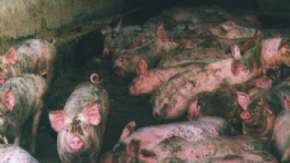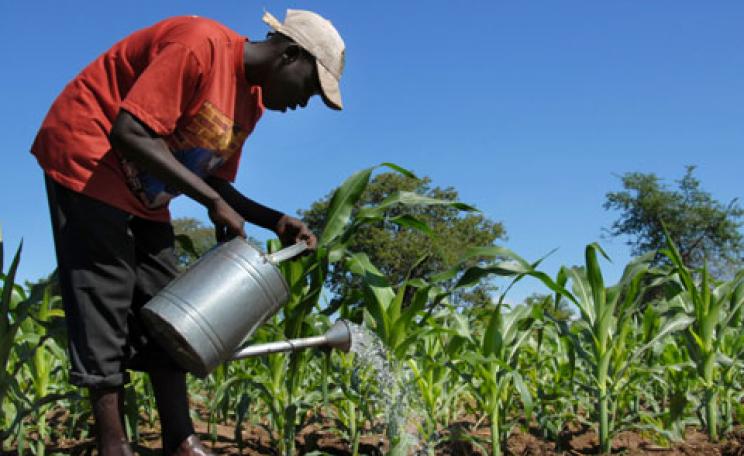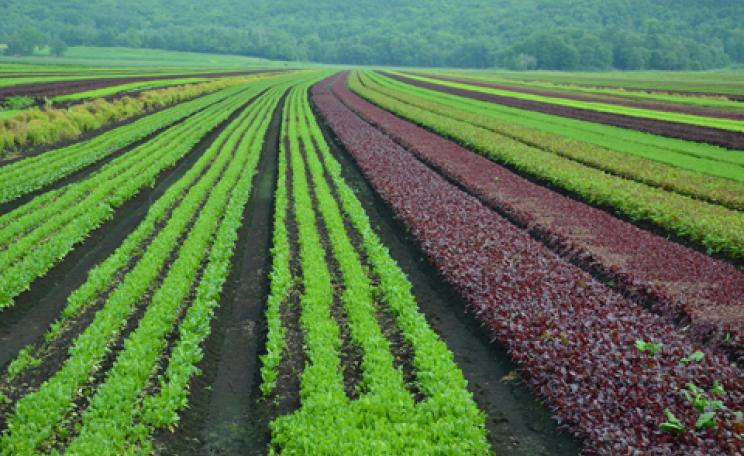To look at the ingredients, the making of a French baguette is child’s play: about five parts flour to three parts water, some yeast and a dash of salt. But in France, baking bread is something of an art form and probably best left in the hands of the country’s vast network of artisan-bakers. Every year, about two million tons of crusty loaves emerge from the hot ovens of some 34,000 boulangeries. And while bread may have been relegated to a supporting role in the French national diet over the past century, the average Frenchman still devours well over a half a baguette a day.
Just an hour’s drive southwest of Paris, an immense territory stretching over 7,500 square-kilometers produces much of the wheat that satisfies this appetite. It’s called La Beauce, otherwise known as France’s breadbasket. Geographically close to Paris and Versailles, La Beauce has always been linked to France’s political stability, according to Steven Kaplan, an American historian specialized in bread and French history.
The N-154 is a popular highway for lorries transporting goods of all sorts from southern parts of France and Europe, to Paris and beyond. It runs through the heart of the Beauce, slicing through vast fields of brown chiseled earth and grassy wheat sprouts that stretch beyond the horizon on either side. This is no-nonsense rurality. There are no quaint fences, hedges or weeds to delineate the motorway from the endless sea of perfectly flat, monotonous farmland. For better or for worse, it seems to say, agriculture has been taken out of the fickle hands of Mother Nature and into the commands of global markets and industry.
Seen from above on a crisp winter day, the region resembles a patchwork of yellow, green and brown geometrical shapes, revealing vast monocultures of wheat, rapeseed and barley – winter crops. What is not visible from this vantage point is a massive underground water reserve that has allowed the region to emerge as the highest-yielding cereal producer across France, and possibly Europe.
Water politics
The Beauce aquifer is one of Europe’s largest, with a holding capacity of some 20 billion cubic meters of water. It sits under six French departments (counties) and two administrative regions (Centre and Ile-de-France), and feeds two major river watersheds (the Loire and the Seine). Until the explosive development of irrigation in the 60s, 70s and 80s, the aquifer had mainly been used to provide drinking water to the region’s rural communities.
By the end of the 80s, a dense network of over 3,000 irrigation wells were pumping water from the aquifer at a rate of between 60 to 250 million cubic meters per year. Where once crops traditionally grown in the region had relied on the winter season’s abundant rains for nourishment, new varieties of spring and summer crops - sugar beets, corn, potatoes, peas and green beans - were now being cultivated, flourishing under gushing showers of Beauce’s subterranean waters.
The development of irrigation in the region also attracted food manufacturers and sugar refineries which forged tightly regulated contracts with Beauce farmers. Liberal access to irrigation was as much a contractual obligation for companies such as McCain Foods as the ability to produce potatoes of a predetermined shape and size to fit easily into factory machinery.
Finite resources
Irrigation made annual precipitation cycles inconsequential. The skies had once dictated the annual fate of agricultural output in the Beauce, as elsewhere, but now farmers could look down to the blue gold under their feet.
Unlimited access to water, a small selection of high-yielding crop varieties and liberal use of synthetic fertilisers meant that farmers could now produce 90-100 quintals (approximately 9000 - 10,000 kilograms) per hectare, according to Lionel Vilain, an agronomist with France Nature Environnement, an environmental protection agency. Conventional yields are closer to 60-80 quintals (6000 - 8000 kilograms) per hectare.
This sense of productivism became a part of the culture. 'For many years, the local press would publish articles promoting the record for the highest producer of the year. It became a sort of competition,' Bernard Rousseau, head of the Water Network with France Nature Environment, told The Ecologist. 'It was also in the interests of some very influential people in the region to promote this kind of mentality.'
But a succession of dry winters in the early 1990s combined with the powerful pumping capacity of thousands of irrigation wells dropped the aquifer to its lowest level on record in 1994, according to Pascal Billault, a hydro-geologist with the Loire-Bretagne water agency. Until then, the volume of water used by irrigating farmers had almost never exceeded 250 million cubic meters. In 1991 however about 420 million cubic meters were siphoned for agriculture. Combined with the 100 million cubic meters required for tap water and industry, the well was essentially bottoming out.
Legal action
The Beauce is not without its beauty. In the picturesque valley of la Conie, host to a conservation site and bird sanctuary, a river by the same name became the centre of a legal battle in 1992 when the Conie River simply dried up. One hundred and fifty locals formed an association and took the territorial government to court for failing to protect the river, fed by the Beauce aquifer. The association won some charges and lost others. But ultimately it was the start of a delicate political process that continues today to reign in the hefty demands of agriculture on the aquifer.
Territorial governments began issuing ad hoc restrictive measures, including limiting the number of days during which farmers were allowed to irrigate in the summer. And in 2000, eight years after the Conie River affair, a highly political multi-stakeholder commission (la Commission Locale de l’Eau, 'CLE'), was formed to negotiate quotas on water with Beauce irrigators.
The negotiation process was made all the more complex by the 'multiplicity of actors' with legitimate stakes in the aquifer, says Olivier Petit, a French economist specialized in water governance. The 70-odd person CLE commission included state representatives from the six departments and two regions, from the two water agencies, from agricultural unions and chambers, from local industry and environmental organisations. Ultimately, an inherent complicity between elected officials in the region and a dominant agricultural sector meant that, despite its sheer size and diversity, agricultural interests weighed in heavily in the commission. Negotiations were tough, says Rousseau, but the rules that came out of the process were weak.
However, the governance system put in place to protect the aquifer is a first of its kind in France. Water meters, financed through the water agencies, have since been installed on all of the irrigation pumps in the region. And farmers have begrudgingly been keeping records of their water use for state administrators.
'Farmers accept it as necessary evil,' says Philippe Lirochon, President of the Eure et Loir department’s Chamber of Agriculture. For the aquifer is not exempt from another dry spell. A study carried out by Sami Bouarfa, an irrigation specialist with the Cemagref environmental research institute, found that, were quotas to be reduced significantly, the operational model put in place by farmers would become obsolete. 'It would mean a return to winter crops, requiring a whole other system than the one that has been put in place progressively over the past 40 years.' The fate of the region’s economy has become inherently tied to the aquifer.
Poisoned water
While the CLE commission was preoccupied with cubic meters and quotas, an alarming public health crisis was slowly unfolding across the region, and most profoundly in the Eure et Loir department. On May 5th, 2005, a daily paper ran a short news piece with the headline 'One in five Euréliens drinks non-potable water. Beneath the headline was a series of maps from 1980 to 2003 depicting the rapid spread of nitrate contamination from synthetic fertilisers in the Beauce aquifer. In July 2008, after a nine-month ban on drinking tap water in one village, the mayor of Cormainville was forced to broaden the restriction to water for cooking.
Recent statistics from the Regional Health Agency reveal that about 40,000 people - 10 per cent of the region’s population, mainly in the smallest villages - receive water that is unfit for human consumption, due to nitrate and pesticide contamination. Unborn babies and newborns are most at risk from nitrates, which are linked a condition called the 'blue baby syndrome'. Health risks associated with pesticides vary widely depending on the chemicals involved and type and frequency of exposure, but can, in some cases, include cancer and damage to the nervous system.
Part of the plan put in place to contain the looming public health crisis included a decision to abandon half of the department’s most contaminated wells, and create of a network of pipelines to link up the villages. Were it not for these measures, which Gilles Deguet, Vice President of the Regional Council, acknowledges as temporary fixes, 40 per cent of the department would now be stuck with non-drinkable water. New wells must drill deeper and deeper to access clean water, but sooner or later 'the pollution catches up with you,' says Deguet.
Residents of the city of Dreux already pay almost twice as much for tap water than the average French citizen. And it’s expected that the cost of water in the department will triple over the next decade. Like the wells, somebody will have to dig deeper and deeper into their pocketbook, but it is unlikely to be the farmers responsible for the pollution. Contrary to the EU’s 'polluter-pays' directive, about 80 per cent of the fees collected by the water agencies come from residents.
Jean-Claude Schmidt, who is responsible for the Eure & Loir department’s water services, has the impossible job of trying to convince farmers in the vicinity of the department’s 40 most important water collection points to change their ways. A perimeter of 1,000 to 7,000 hectares around each collection point has been drawn, corresponding to the area within which rainwater drains into the aquifer. In these 'catchment zones', the idea goes, grassland buffers that soak up nitrates, and all round greener agricultural practices, will be cultivated. Should the plan work about 100,000 hectares - almost 25 per cent of the region’s agricultural lands - could benefit from environmental protection measures.
Exacerbating pollution
The idea is not a new one. About two decades ago, Nestlé Water’s Vittel brand of bottled water found it necessary to invest heavily in repurchasing agricultural lands around their springs and co-opting local farmers to adopt greener practices in order to safeguard their product from agricultural pollution. But the public funds allocated to Schmidt’s daunting task can hardly compete with those of a private company like Vittel. 'When the price of wheat took off this year, we weren’t able to keep up. The compensations farmers were demanding were just too high,' says Schmidt.
A bullish wheat market does more than price environmental protection measures out of the market. It exacerbates pollution. Vilain describes an almost linear relationship between crop prices and the use of fertiliser and pesticides. In a bid to boost yields, 'when wheat prices are high, they use more fertiliser. From the rational economic perspective of a businessman, it pays to pollute,' he says.
If there’s something environmentalists and farmers can agree on, it’s that any long-term solution starts with economic considerations. While Vilain advocates a pan-European tax on fertilisers and pesticides, Cyril Deshayes, who heads WWF-France’s fresh water department, speaks of the purchasing power of the government - which buys significant quantities of food for schools and hospitals - to establish contracts with organic farmers and create a more favourable marketplace for organic food. Whatever the tactic, says Lirochon, 'We must maintain the economic balance of our farming enterprises, while responding to our obligation to consider the impacts of agricultural pollution on water.
Inertia?
As nitrate and pesticide molecules continue to percolate into the aquifer with no sign of abate, there’s one word on the lips of experts. Inertia. Once here, the molecules will remain for a very long time. According to recent study conducted in the neighbouring Seine watershed, a full-scale conversion to organic agriculture is theoretically the only way to bring nitrogen contamination back in check, a scenario that Gilles Billen, co-author of the study calls 'utopian'.
But there’s another kind of inertia that characterises this crisis, and it is human. For all the plant life that Beauce farmers nurture on their lands year after year, they then go and foul the element that is the very essence of all life, say critics. But it’s easy to blame the farmers. Others are to blame too – from agro-chemical companies to EU policy makers. 'You just had to look at a map of agricultural pollution in France,' says Rousseau, 'to see how it maps up with European subsidies.'
Meanwhile, an officially sanctioned recipe for 'traditional' French bread reads: 'Flour is the most important ingredient. Its quality is a baker’s first consideration... water is used to bind the flour particles together. Without it, kneading is impossible. Water must be potable, non-mineralized and with little chlorine, which would otherwise hinder fermentation...'
France’s breadbasket may abound in wheat and flour, but it has forgotten the ingredient that - quite simply - holds it all together.
Carolyn Lebel is a freelance journalist, in Paris.
| READ MORE... | |
 |
INVESTIGATION Special Report Supermarkets: Bread Supermarket in-store bakeries are nothing but bogus ‘retail theatre’ |
 |
INVESTIGATION BLT Sandwich: The Big Lifestyle Trade Off Is it worse than Mc Donalds? The BLT sandwich is an icon, the ultimate symbol of convenience culture. Tesco alone sells 5 million a year. This is what the £1.80 you pay for your BLT buys... |
 |
HOW TO MAKE A DIFFERENCE CASE STUDY: baking and selling real bread The creation of the modern loaf is an industrial process that uses a cocktail of artificial ingredients - but for taste, bite and goodness, nothing beats the old ways. Laura Sevier meets a baker bidding to become the saviour of our daily bread |
 |
HOW TO MAKE A DIFFERENCE Love your Lakes: a campaign to get phosphates out of the Lake District Following the closure of some of the UK's most stunning lakes, a dynamic campaign has been set up to stop phosphates from washing detergents causing algal blooms |
 |
NEWS Hungary toxic spill 'could be worse' than Baia Mare cyanide disaster Greenpeace says responsibility of aluminum company is 'quite clear' as campaigners urge stricter controls on other hazardous waste sites around the Danube region |








